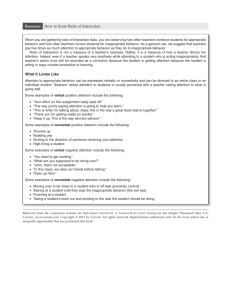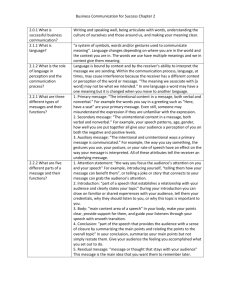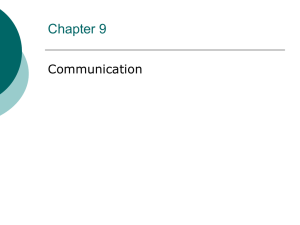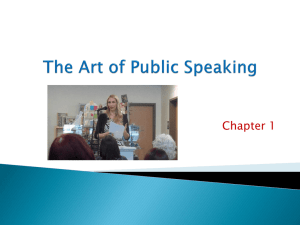MS-Word - Business Information Management
advertisement
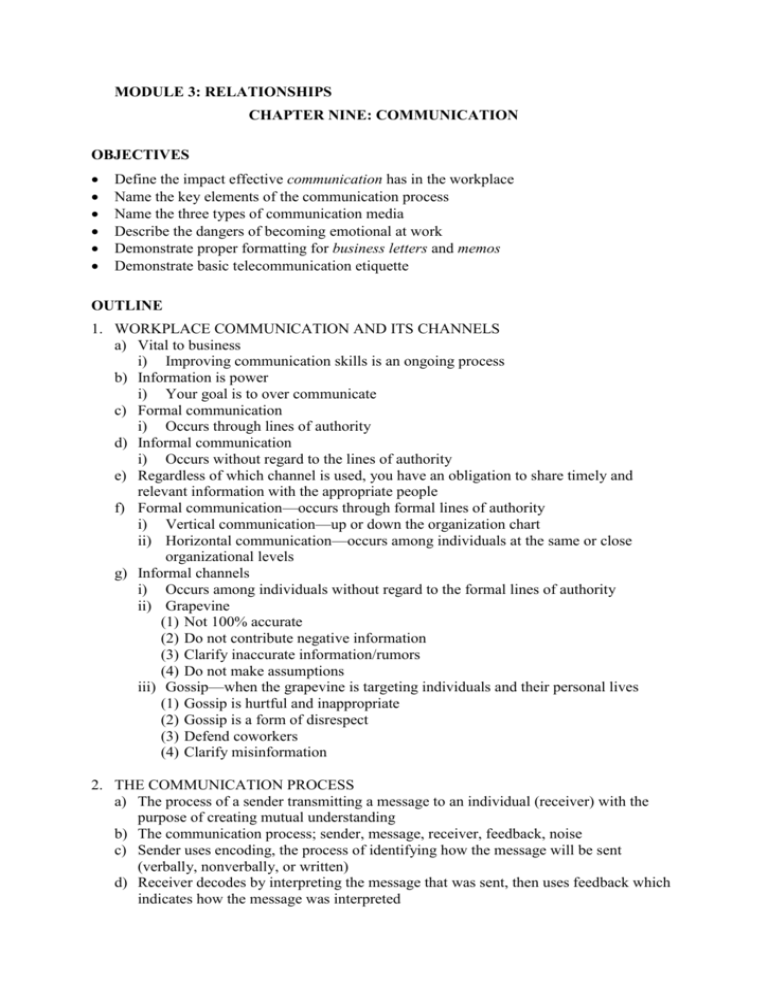
MODULE 3: RELATIONSHIPS CHAPTER NINE: COMMUNICATION OBJECTIVES Define the impact effective communication has in the workplace Name the key elements of the communication process Name the three types of communication media Describe the dangers of becoming emotional at work Demonstrate proper formatting for business letters and memos Demonstrate basic telecommunication etiquette OUTLINE 1. WORKPLACE COMMUNICATION AND ITS CHANNELS a) Vital to business i) Improving communication skills is an ongoing process b) Information is power i) Your goal is to over communicate c) Formal communication i) Occurs through lines of authority d) Informal communication i) Occurs without regard to the lines of authority e) Regardless of which channel is used, you have an obligation to share timely and relevant information with the appropriate people f) Formal communication—occurs through formal lines of authority i) Vertical communication—up or down the organization chart ii) Horizontal communication—occurs among individuals at the same or close organizational levels g) Informal channels i) Occurs among individuals without regard to the formal lines of authority ii) Grapevine (1) Not 100% accurate (2) Do not contribute negative information (3) Clarify inaccurate information/rumors (4) Do not make assumptions iii) Gossip—when the grapevine is targeting individuals and their personal lives (1) Gossip is hurtful and inappropriate (2) Gossip is a form of disrespect (3) Defend coworkers (4) Clarify misinformation 2. THE COMMUNICATION PROCESS a) The process of a sender transmitting a message to an individual (receiver) with the purpose of creating mutual understanding b) The communication process; sender, message, receiver, feedback, noise c) Sender uses encoding, the process of identifying how the message will be sent (verbally, nonverbally, or written) d) Receiver decodes by interpreting the message that was sent, then uses feedback which indicates how the message was interpreted e) Noise is anything that interferes with the communication process (audible and not) f) Communication Media i) Verbal, nonverbal, written TALK IT OUT: Identify the noises you experience during class? 3. VERBAL COMMUNICATION a) Using words to send the message i) Select the proper words ii) Stop and listen (1) Active listening-the receiver provides full attention without distraction (2) Passive listening-the receiver is selectively hearing parts of the message, focused more on his or her response TALK IT OUT: In what situations is it easy to be in “nonlistening” mode? What can an individual do to improve his or her listening skills in such a situation? 4. NONVERBAL COMMUNICATION a) Communicate through body language i) Eye contact ii) Facial expressions (smiles or frowns) iii) Nodding iv) Body positioning v) Proxemics (space) b) Emotions at work i) Make every attempt to not become emotional at work ii) Emotions take away our ability to think logically iii) If you cry or become angry, excuse yourself from the situation iv) In private, deal with your emotions v) Open displays of anger are inappropriate 5. WRITTEN COMMUNICATION a) A form of business communication that is either printed, handwritten, or sent electronically b) Conveys aptitude and attitude i) Receiver draws conclusions based upon grammar, vocabulary, presentation, and formatting used in written communication ii) Common forms include letters, memos, and electronic messages c) Written communication basics i) Professional, formal presentation ii) Error free iii) Clear message with carefully chosen words iv) With exception of handwritten thank-you notes, all written business communication should be keyboarded d) Creating written communication i) Plan your message (1) What you want to communicate (2) To whom you need to communicate (3) What is the desired action ii) Keep free from anger or negativity iii) If for a negative situation (1) Begin with a positive note and then factually address the situation iv) Keep correspondence short and simple 6. THE BUSINESS LETTER a) A formal written form of communication sent to individuals outside the organization b) Proper business format i) Written on company letterhead or as an attachment with e-mail ii) Error free iii) Proofread, sign, and date prior to mailing iv) Use company #10 mailing envelope SEE FIGURE 9-2 IN TEXT (on PowerPoint) 7. THE BUSINESS MEMO a) A formal form of written business communications set within an organization b) Sometimes called Interoffice Memorandums c) Used for internal communication d) Include receiver’s name, date, and subject e) Include all facts, but be brief f) Memos should be no longer than one page SEE FIGURE 9-4 IN TEXT (on PowerPoint) 8. THANK-YOU NOTES a) Handwritten, in pen, on a note card b) Just a few sentences c) Sent when someone does something for you that takes more than five minutes of their time, or when they give you a gift d) Note should be delivered as soon as possible SEE FIGURE 9-6 IN TEXT (on PowerPoint) TALK IT OUT: When is it appropriate to send a handwritten message? And, to whom? 9. DOCUMENTATION a) A formal record of events or activities i) Provides evidence to support employee evaluations, client billing, business operations, workplace injury, angry customer, employee conflict b) Describes the who, what, when, where, and why of situation c) Includes date, time, and location of event d) Electronic, journal, company form, or notes on a calendar e) Depending on situation: i) Includes who was present/witnesses ii) Notes how people behaved or responded to the event f) Documentation is for your personal reference g) Keep in confidential location 10. PRESENTATIONS a) Both formal and informal presentations are a normal workplace event b) Rich in media i) Written, verbal, visual, non-verbal c) Successful presentations: i) Begin with a goal ii) Ensure each word, visual aid, activity, and handout supports the presentation goal d) Three elements of formal presentations i) Verbal, visual, support ii) Verbal (1) Do not directly read from visual, speak clearly and slowly, use professional and appropriate language, face the audience, beware of verbal and nonverbal nervous gestures iii) Visual (1) Anything the audience will view or any activity the audience will perform during the presentation (a) Pretest technology and equipment (b) Keep activity simple and not distracting iv) Support content (1) Reinforces verbal and visual message (2) Professional and visually appealing v) Practice makes perfect 11. SLANG AND FOUL LANGUAGE a) Slang is an informal language used among a particular group i) Avoid using slang in the workplace, including verbal and written communications b) It is not appropriate to use foul language i) If you slip, immediately apologize 12. POTENTIALLY OFFENSIVE NAMES a) Names that could be considered sexist and offensive are inappropriate in a business setting b) Using inappropriate names toward coworkers will expose you and your company to a potential sexual harassment lawsuit c) Eliminate potentially offensive names from your workplace vocabulary Instead of Postman Policeman Use Postal carrier Police officer Waitress Server Stewardess Flight attendant Maid Housekeeper 13. NOT ALWAYS ABOUT YOU a) Avoid the use of the word “I” b) Focus the conversation on others


